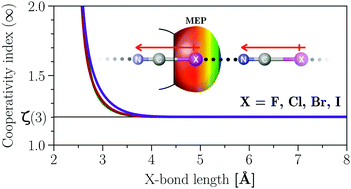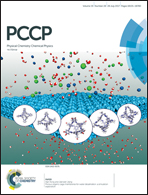Modeling cooperative effects in halogen-bonded infinite linear chains
Abstract
Non-additivity in noncovalent interactions is an important aspect of complex systems that can lead to stronger (cooperative) interactions when three or more molecular units influence each other. The halogen bond (XB) is a highly-directional noncovalent interaction that has been found to be cooperative. Here the strength and nature of cooperativity arising in X-bonded infinite linear chains of cyanogen halides and 4-halopyridines are investigated by means of density functional theory calculations. It is found that cyanogen halide chains are highly cooperative (up to 77%), whereas pyridines are only slightly cooperative (below 21%). It is demonstrated that XB and its non-additivity can be modeled as the sum of a local term, which depends on first nearest-neighbors only, and long-range effective dipole–dipole attractions. It is shown that the local term in cyanogen halides primarily accounts for repulsive short-range screened Coulomb interactions, whereas in 4-halopyridines such a term also includes attractive contributions, which are particularly sizeable in some elongated XB conformations. This outcome reveals differences in the nature of the XBs formed in these molecular systems. Nevertheless, it is shown that both systems behave as effective point dipoles regarding cooperative effects, at any point of the XB dissociation path. As such, these results are useful contributions for the understanding and modeling of non-additive effects of noncovalent interactions.



 Please wait while we load your content...
Please wait while we load your content...